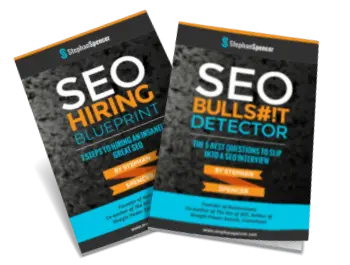This article was originally published under Multi-Channel Merchant.
With over a billion search queries run online every day—each of which must be matched against hundreds of millions websites to find the best results to display—it’s clear that Google and the other search engines face a Herculean task when it comes to organizing the world’s information.
Somehow, inside the black box that is Google’s algorithm, the websites that provide the most relevant and authoritative results are promoted to the top. And the ones that aren’t at the top are largely ignored by searchers. To increase your chances of being favored in this process, you must apply the latest and best practices in search engine optimization (SEO).
SEO tutorials abound, both online and offline (including my book The Art of SEO, now in its second edition), but figuring out how to apply their instructions to your own site can seem daunting, to say the least. A more workable approach may be the simple “best practices” outlined below. Just these seven steps will, I’m confident, “move the needle” for you.
Make the most of your homepage.
Of all your web pages, your homepage is typically given the most weight by the search engines—so don’t waste it! Here’s what you need to do to make the most of this opportunity:
- Include text: It’s critical that you have indexable text on the homepage—it gives the search engines something to sink their teeth into! Fossil isn’t doing itself any favors by using a homepage composed almost entirely of image files.
- Avoid “SEO copy”: I define “SEO copy” as text that’s written primarily for the search engines rather than for humans. Usually it’s tucked away below the fold, sometimes even below the copyright statement (how obvious is that?). It’s useless text full of “keyword stuffing” and, not surprisingly, Google is on to this trick. An egregious example can be found hiding at the bottom of the RedEnvelope.com homepage. Ask yourself: “Does this content add value to the user experience?” If the answer is no, don’t use it. It’s not that hard to make keyword-rich content that is actually valuable to the reader. Bed Bath & Beyond does it with its “quick tips” (https://www.bedbathandbeyond.com/nodePage.asp?RN=14&).
- Avoid country selectors: As much as I hate country selectors, I recognize that sometimes you may have no choice but to use one. If that’s your situation, please at least configure your website so that the search engines don’t interpret the country selector as your homepage. Automatically redirect search engine spiders to the homepage of your primary country’s website. Otherwise, you’re presenting a country list as your homepage (like AirCanada.com). View Google’s cached version of your homepage URL (e.g., search for “cache:www.aircanada.com”) to ensure you are redirecting properly.
Create content with “viral” potential.
Inbound links are critical to your rankings. To increase the likelihood that people will link to you, make your content truly compelling, even “remarkable” (I’m thinking of Seth Godin’s definition here, i.e. “worth remarking about”). Viral content can take many forms—top-10 lists, quizzes, articles, infographics, comics, videos and so on. It’s usually humorous or super-useful, and thus irresistible to share—for example, the 5 lb. Gummy Bear on Vat19.com or the “Redneck Home Remodels” featured on b-to-b and b-to-c flooring merchant BuildDirect.com.
Clean up your URLs.
It’s not unusual for an ecommerce site to have spider-unfriendly URLs—a mile long with numerous parameters, and sometimes even (Heaven forbid) session IDs. Contrast the following bad example with the good example that follows it:
“Bad” URL
https://www.bestbuy.com/site/olstemplatemapper.jsp?id=pcat17080&type=page&qp=q70726f63657373696e6774696d653a3e313930302d30312d3031~~cabcat0100000%23%230%23%23wv~~cabcat0101000%23%230%23%236e~~nf396||4f6e2053616c65&list=y&nrp=15&sc=TVVideoSP&sp=-bestsellingsort+skuid&usc=abcat0100000
“Good” URL
https://www.shoebuy.com/high-heel-womens-shoes.htm
Make your URLs more palatable to the search engines by making them short; include keywords, separate the words with hyphens (not underscores), and avoid parameters in the “query string” (after the question mark) whenever possible.
Additionally, short, clean URLs get clicked on more often in the search results—twice as often as long URLs, in fact (source: MarketingSherpa). You can fix your ugly URLs with a server module/plug-in like mod_rewrite or ISAPI_rewrite, or with a proxy server like Organic Search Optimizer from Covario.
HTML-ify your customer reviews.
User reviews are being integrated into ecommerce sites more and more frequently, and with good reason! Not only do these personal testimonials build trust with customers, they also provide additional text, often with relevant keywords.That latter benefit will be lost, however, if the reviews are incorporated into the product page via JavaScript. The user-generated content should be in the HTML so it can be visible to the spiders. If JavaScript must be used, provide an alternate HTML version too.
As an example, consider the product reviews found on REI.com. Although JavaScript is utilized for display purposes, the review copy is present in the HTML, and is thus visible to the spiders. This allows REI to provide a rich user experience and draw SEO benefits from the keywords present in these reviews.
Avoid Google’s duplicate content filter.
If Google were to show substantively the same results on the first page, it would be a poor user experience. Search engine users want diversity in the search results. So, no wonder, Google works hard to filter out duplicate content. Duplicate content can be content that also appears on other sites besides your own, or it can be repeated content on multiple URLs within your own site. Pages that are deemed “duplicate content” by Google may not be shown in the results—meaning you could be missing out on valuable Google-referred traffic. Take these steps:
- Avoid using the same manufacturer-supplied product descriptions that everyone else uses (see examples in the Google screenshot below). Rewrite them or at least augment them with additional unique copy.
- Check your site in Google Webmaster Tools. Pay particular attention to the duplicate title tags and duplicate meta-descriptions reports.
- Check your site in Blekko using its “duptext” slashtag (you’ll need an account).
- If you have separate websites for different countries, and some of those country sites repeat the same content, properly “label” it using the preferred geographic region tool in Google Webmaster Tools.
Deploy SEO microdata.
“Microdata” refers to additional modifiers you can add to your website’s code in order to provide the search engines with more information about the content contained on your web pages. By adding extra meaning to your data in this way, you’ll be eligible to have “rich snippets” in your Google listings, which allow more information about your site to be displayed in the search results.
Complete details about the specific types of microdata that are available, as well as how to integrate them into your website, can be found on Schema.org.
Learn from the competition.
Instead of getting upset about other companies ranking higher than you in the organic search results (consider this fun definition: SPAM = Sites Positioned Above Me), study them so that you can beat them at their own game.
You can obtain a fairly extensive list of keywords that your competitors (and anyone else who is outranking you) are obtaining search traffic from with tools like SEMRush.com and Searchmetrics.com.
You can also get a sense for which keywords your competitors are targeting by examining their sites’ title tags and meta-tags. Don’t copy them verbatim, but do evaluate the search query volume for each keyword to see which keywords are viable targets.
Of course, watch what the “big boys” in your industry are doing.(For example, if you’re a niche shoe retailer like BirkenstockCentral.com, keep an eye on what Zappos is up to.) Industry leaders may have marketing budgets that exceed your total revenue, so there’s a good chance they’ve hired the best and brightest SEO minds to improve their websites. Watching the changes they implement could give you this same insider advice, but at a much lower price! Caution: Just because they are big doesn’t mean they are skilled at SEO. Use your best judgment when deciding who to emulate and who not to.
As you incorporate these techniques into your ecommerce site, keep in mind that they are merely a starting point. They are, by no means, sufficient. Happy optimizing!







